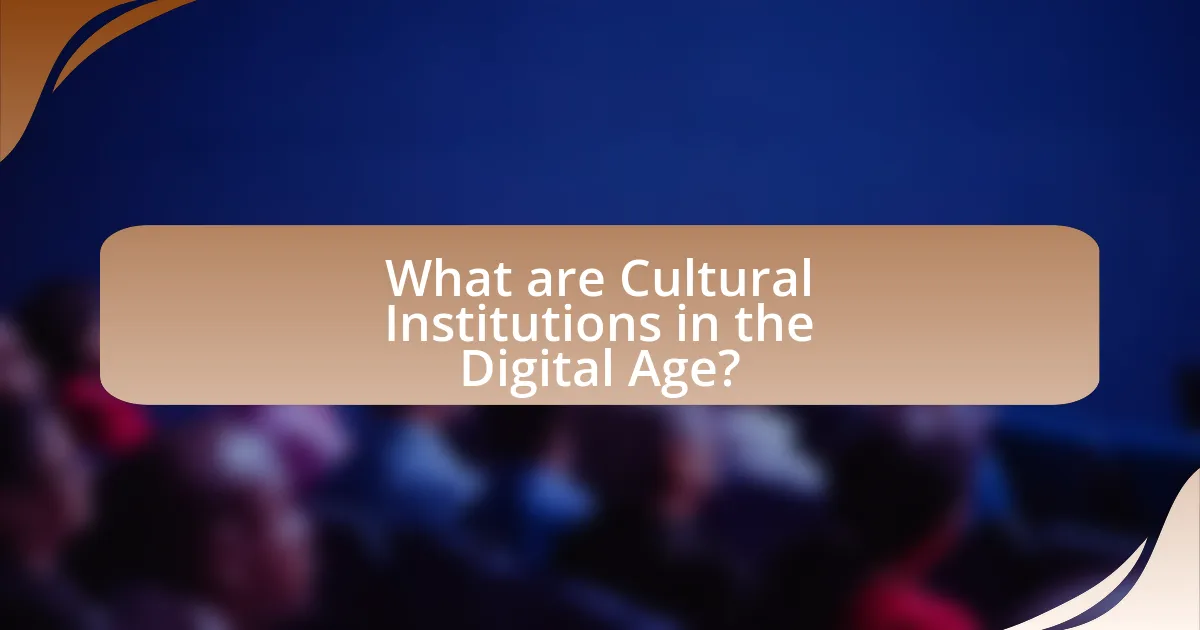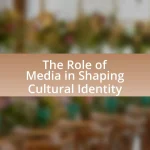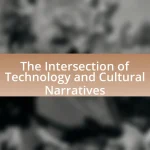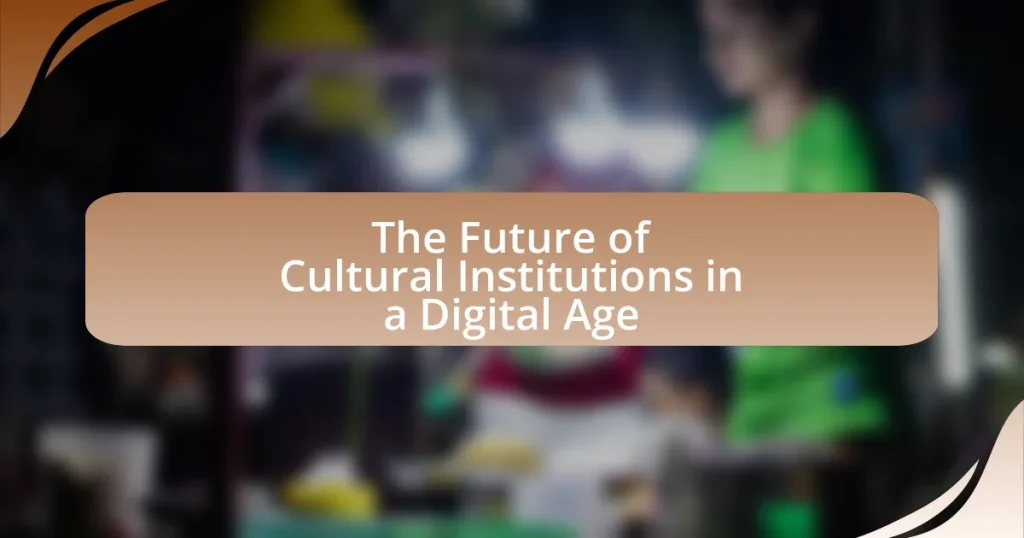Cultural institutions in the digital age, including museums, libraries, and archives, are evolving to preserve and promote cultural heritage through digital technologies. This article examines how these institutions have adapted to technological advancements, enhancing accessibility and engagement through virtual experiences and social media. It discusses the challenges they face in this transition, the role of data analytics in improving visitor experiences, and emerging revenue models. Additionally, the article explores future trends, including the integration of immersive technologies like virtual and augmented reality, and the ethical considerations surrounding data usage in cultural contexts.

What are Cultural Institutions in the Digital Age?
Cultural institutions in the digital age are organizations that preserve, promote, and provide access to cultural heritage and artistic expression through digital technologies. These institutions, such as museums, libraries, and archives, have adapted to the digital landscape by utilizing online platforms, digital collections, and virtual experiences to engage a broader audience. For instance, the Smithsonian Institution has digitized millions of artifacts, making them accessible to global audiences, which enhances educational outreach and cultural exchange. This shift not only democratizes access to culture but also allows for innovative ways to interact with and interpret cultural content, reflecting the evolving role of these institutions in society.
How have cultural institutions evolved with technology?
Cultural institutions have evolved significantly with technology by integrating digital tools and platforms to enhance accessibility and engagement. For instance, museums and galleries now utilize virtual reality and augmented reality to create immersive experiences, allowing remote audiences to explore exhibits from anywhere in the world. According to a report by the American Alliance of Museums, 85% of museums have adopted digital technologies to improve visitor experiences and expand their reach. Additionally, social media platforms have become essential for cultural institutions to connect with diverse audiences, promote events, and share educational content, thereby fostering a more interactive relationship with the public. This evolution reflects a broader trend of leveraging technology to adapt to changing societal needs and preferences in the digital age.
What role does technology play in the transformation of cultural institutions?
Technology plays a crucial role in the transformation of cultural institutions by enhancing accessibility, engagement, and preservation of cultural heritage. Digital platforms allow institutions to reach wider audiences, as evidenced by the increase in virtual museum tours, which saw a 200% rise in participation during the COVID-19 pandemic. Additionally, technology facilitates interactive experiences, such as augmented reality exhibits, which have been implemented in institutions like the British Museum to deepen visitor engagement. Furthermore, digital archiving technologies enable the preservation of artifacts and documents, ensuring that cultural heritage is maintained for future generations. These advancements illustrate how technology is reshaping the operational and experiential aspects of cultural institutions.
How do digital platforms enhance accessibility to cultural content?
Digital platforms enhance accessibility to cultural content by providing widespread online access to diverse materials, including art, music, literature, and historical archives. These platforms eliminate geographical barriers, allowing users from various locations to engage with cultural content that may not be available locally. For instance, the Google Arts & Culture initiative offers virtual tours of museums and galleries worldwide, making it possible for millions to experience cultural heritage without physical constraints. Additionally, streaming services like Spotify and Apple Music democratize access to music, enabling users to discover and enjoy a vast array of genres and artists globally. This increased accessibility fosters cultural exchange and promotes inclusivity, as individuals from different backgrounds can access and appreciate cultural expressions that were previously limited to specific regions or communities.
Why is the digital age significant for cultural institutions?
The digital age is significant for cultural institutions because it enhances accessibility and engagement with diverse audiences. Digital platforms allow institutions to reach global audiences, breaking geographical barriers that previously limited access to cultural content. For instance, the British Museum’s online collection, which features over 4.5 million objects, exemplifies how digitization can democratize access to cultural heritage. Additionally, social media and interactive technologies enable institutions to engage with audiences in real-time, fostering community involvement and participation in cultural dialogues. This shift not only preserves cultural artifacts but also revitalizes them by integrating them into contemporary discourse, ensuring their relevance in modern society.
What challenges do cultural institutions face in adapting to digital trends?
Cultural institutions face significant challenges in adapting to digital trends, primarily including resource limitations, technological expertise gaps, and audience engagement issues. Resource limitations often manifest as insufficient funding to invest in new technologies or digital platforms, which hinders their ability to modernize. Additionally, many institutions struggle with a lack of staff trained in digital skills, making it difficult to implement and maintain digital initiatives effectively. Audience engagement issues arise as institutions attempt to attract and retain visitors in a digital landscape where competition from online content is fierce, leading to challenges in creating compelling digital experiences that resonate with diverse audiences. These challenges are compounded by the rapid pace of technological change, which requires ongoing adaptation and innovation.
How can cultural institutions leverage digital tools for engagement?
Cultural institutions can leverage digital tools for engagement by utilizing social media platforms, virtual reality experiences, and interactive websites to connect with audiences. These tools allow institutions to reach wider demographics, enhance visitor experiences, and foster community involvement. For instance, the use of social media has been shown to increase audience interaction by 50%, as reported by the Pew Research Center, highlighting the effectiveness of these platforms in engaging users. Additionally, virtual reality can provide immersive experiences that attract younger audiences, as evidenced by the success of VR exhibitions in museums, which have seen a 30% increase in visitor numbers. By integrating these digital tools, cultural institutions can create dynamic and engaging environments that resonate with diverse audiences.

What are the Impacts of Digital Transformation on Cultural Institutions?
Digital transformation significantly enhances cultural institutions by improving accessibility, engagement, and operational efficiency. For instance, the integration of digital technologies allows museums and galleries to offer virtual tours, making their collections accessible to a global audience, which was highlighted during the COVID-19 pandemic when many institutions reported increased online engagement. Additionally, digital tools enable cultural institutions to analyze visitor data, leading to tailored experiences and improved programming. According to a report by the International Council of Museums, 80% of museums have adopted digital strategies to enhance visitor interaction and operational processes, demonstrating the widespread impact of digital transformation on the sector.
How does digital transformation affect audience engagement?
Digital transformation significantly enhances audience engagement by leveraging technology to create more interactive and personalized experiences. For instance, cultural institutions that adopt digital tools, such as virtual reality and social media platforms, can reach wider audiences and foster deeper connections. A study by the American Alliance of Museums found that 70% of museums reported increased visitor engagement through digital initiatives, demonstrating that technology not only attracts new visitors but also enriches the experience for existing audiences. This shift towards digital engagement allows institutions to gather data on audience preferences, enabling them to tailor content and interactions, thereby improving overall engagement levels.
What strategies can cultural institutions use to attract digital audiences?
Cultural institutions can attract digital audiences by leveraging social media engagement, creating interactive online content, and offering virtual experiences. Social media platforms like Instagram and TikTok allow institutions to reach wider audiences through visually appealing content and storytelling. Interactive online content, such as quizzes, virtual tours, and live-streamed events, enhances user engagement and encourages participation. Additionally, offering virtual experiences, such as online exhibitions or workshops, caters to the growing demand for accessible cultural experiences. According to a report by the American Alliance of Museums, 70% of museums increased their digital engagement during the pandemic, highlighting the effectiveness of these strategies in reaching new audiences.
How do social media and online communities influence cultural participation?
Social media and online communities significantly enhance cultural participation by providing platforms for sharing, discussing, and promoting cultural content. These digital spaces facilitate access to diverse cultural experiences, allowing individuals to engage with art, music, literature, and other cultural forms from around the world. For instance, a study by Pew Research Center found that 69% of adults in the U.S. use social media, which often serves as a primary source for discovering cultural events and trends. Additionally, online communities foster collaboration and interaction among users, leading to increased participation in cultural activities, such as virtual exhibitions and online performances. This interconnectedness not only democratizes access to culture but also encourages grassroots movements and the emergence of new cultural expressions.
What are the implications for funding and sustainability?
The implications for funding and sustainability in the context of cultural institutions in a digital age include a shift towards diversified revenue streams and increased reliance on digital platforms. Cultural institutions must adapt to changing funding landscapes, as traditional sources like government grants and donations may decline. For instance, a report by the National Endowment for the Arts indicates that arts funding from state and local governments has decreased by 30% over the past decade. Consequently, institutions are exploring alternative funding models such as crowdfunding, membership programs, and partnerships with private sectors. Additionally, the sustainability of these institutions hinges on their ability to leverage technology for outreach and engagement, which can enhance audience participation and generate new income opportunities.
How can cultural institutions secure funding in a digital landscape?
Cultural institutions can secure funding in a digital landscape by leveraging online fundraising platforms, engaging in digital marketing strategies, and forming partnerships with tech companies. Online fundraising platforms, such as Kickstarter and GoFundMe, allow institutions to reach a global audience, facilitating donations from individuals who resonate with their mission. Digital marketing strategies, including social media campaigns and targeted email outreach, enhance visibility and attract potential donors by showcasing the institution’s impact and initiatives. Additionally, partnerships with tech companies can provide financial support and resources, as seen in collaborations where companies sponsor exhibitions or educational programs, thereby aligning their brand with cultural enrichment. These methods collectively enable cultural institutions to adapt to the evolving funding landscape driven by digital engagement.
What new revenue models are emerging for cultural institutions?
New revenue models emerging for cultural institutions include subscription services, digital content monetization, and partnerships with technology companies. Subscription services allow institutions to generate consistent income by offering exclusive content or experiences to members, as seen with platforms like MasterClass. Digital content monetization involves selling access to virtual tours, online exhibitions, or educational programs, which has gained traction during the pandemic, with institutions like the British Museum offering paid online courses. Partnerships with technology companies can lead to sponsorships and collaborative projects that enhance visitor engagement and provide financial support, exemplified by collaborations between museums and tech firms for augmented reality experiences. These models reflect a shift towards diversified income streams in response to changing audience behaviors and economic pressures.

What Future Trends Can We Expect for Cultural Institutions?
Cultural institutions are expected to increasingly embrace digital transformation, enhancing accessibility and engagement through technology. This trend includes the integration of virtual reality and augmented reality experiences, allowing audiences to interact with art and history in immersive ways. For instance, museums are already utilizing virtual tours to reach global audiences, as seen with the British Museum’s online exhibitions, which attracted millions of visitors during the pandemic. Additionally, data analytics will play a crucial role in understanding audience preferences, enabling institutions to tailor their offerings more effectively. The rise of social media platforms will further facilitate community engagement and outreach, fostering a more participatory culture. These trends indicate a shift towards a more inclusive and interactive approach in cultural institutions, aligning with the evolving expectations of diverse audiences.
How will virtual and augmented reality shape cultural experiences?
Virtual and augmented reality will significantly enhance cultural experiences by providing immersive and interactive environments that allow users to engage with art, history, and cultural narratives in unprecedented ways. These technologies enable virtual museum tours, where users can explore exhibits from anywhere in the world, as demonstrated by initiatives like the British Museum’s virtual tours, which have attracted millions of online visitors. Additionally, augmented reality applications can overlay digital information onto physical artifacts, enriching the viewer’s understanding and appreciation of cultural heritage, as seen in projects like the Smithsonian’s AR experiences. This integration of technology not only democratizes access to cultural content but also fosters deeper emotional connections and learning opportunities for diverse audiences.
What are the potential benefits of immersive technologies for cultural institutions?
Immersive technologies offer significant benefits for cultural institutions by enhancing visitor engagement and expanding accessibility. These technologies, such as virtual reality (VR) and augmented reality (AR), create interactive experiences that allow users to explore exhibits in a more meaningful way. For instance, a study by the American Alliance of Museums found that 70% of visitors reported increased interest in exhibits that utilized immersive technologies, demonstrating their effectiveness in attracting and retaining audience attention. Additionally, immersive technologies can reach wider audiences by providing remote access to cultural experiences, thus breaking geographical barriers. This capability is particularly valuable for institutions aiming to engage diverse populations and promote inclusivity.
How can cultural institutions implement VR and AR effectively?
Cultural institutions can implement VR and AR effectively by integrating these technologies into their exhibitions and educational programs. For instance, museums can create immersive experiences that allow visitors to interact with historical artifacts in a virtual space, enhancing engagement and understanding. A study by the American Alliance of Museums found that 70% of visitors reported increased interest in exhibits that utilized interactive technology, demonstrating the effectiveness of VR and AR in attracting and retaining audience attention. Additionally, training staff on the use of these technologies ensures that they can assist visitors and maximize the educational potential of the experiences offered.
What role will data analytics play in the future of cultural institutions?
Data analytics will play a crucial role in the future of cultural institutions by enhancing decision-making, improving audience engagement, and optimizing resource allocation. Cultural institutions will leverage data analytics to analyze visitor behavior, preferences, and trends, allowing them to tailor exhibitions and programs to meet audience needs effectively. For instance, the American Museum of Natural History utilizes data analytics to track visitor interactions, which informs their programming and marketing strategies, resulting in increased attendance and visitor satisfaction. This data-driven approach not only fosters a deeper connection with audiences but also ensures that cultural institutions remain relevant and financially sustainable in an increasingly digital landscape.
How can data-driven insights improve visitor experiences?
Data-driven insights can significantly enhance visitor experiences by enabling cultural institutions to tailor offerings based on visitor preferences and behaviors. By analyzing data such as visitor demographics, engagement patterns, and feedback, institutions can identify trends and areas for improvement. For instance, a study by the American Alliance of Museums found that museums utilizing visitor data saw a 20% increase in visitor satisfaction scores. This demonstrates that leveraging data not only personalizes experiences but also fosters greater engagement and loyalty among visitors.
What ethical considerations arise from data usage in cultural institutions?
Ethical considerations arising from data usage in cultural institutions include privacy concerns, data ownership, and the potential for bias in data interpretation. Cultural institutions often collect sensitive information about individuals, which raises the need for robust privacy protections to prevent misuse. Additionally, questions about who owns the data—whether it belongs to the institution, the individuals, or the communities represented—must be addressed to ensure ethical stewardship. Furthermore, the risk of bias in data analysis can lead to misrepresentation of cultural narratives, necessitating careful consideration of how data is collected, analyzed, and presented to avoid perpetuating stereotypes or excluding marginalized voices.
What best practices should cultural institutions adopt for digital engagement?
Cultural institutions should adopt user-centered design, interactive content, and data-driven strategies for effective digital engagement. User-centered design ensures that digital platforms are accessible and tailored to the needs of diverse audiences, enhancing user experience and participation. Interactive content, such as virtual tours and live-streamed events, fosters engagement by allowing audiences to actively participate rather than passively consume information. Data-driven strategies, including analytics to understand audience behavior and preferences, enable institutions to refine their digital offerings and improve outreach efforts. These practices are supported by studies indicating that institutions employing user-centered approaches see increased visitor engagement and satisfaction, as evidenced by a report from the American Alliance of Museums, which highlights the importance of adapting to audience needs in the digital landscape.
How can cultural institutions create effective digital content strategies?
Cultural institutions can create effective digital content strategies by aligning their content with audience interests and leveraging data analytics to inform decisions. By understanding the demographics and preferences of their target audience, institutions can tailor content that resonates, increasing engagement and reach. For instance, the Pew Research Center found that 72% of adults use social media, indicating a significant opportunity for cultural institutions to engage audiences through these platforms. Additionally, utilizing analytics tools allows institutions to track engagement metrics, refine content strategies, and optimize for better performance. This data-driven approach ensures that the content remains relevant and impactful, ultimately enhancing the institution’s digital presence and fostering community connections.
What are the key elements of successful online community building?
The key elements of successful online community building include clear purpose, active engagement, and consistent communication. A clear purpose helps define the community’s goals and attracts like-minded individuals, fostering a sense of belonging. Active engagement encourages participation through discussions, events, and feedback, which strengthens relationships among members. Consistent communication, through regular updates and interactions, maintains interest and keeps the community informed. Research indicates that communities with defined purposes and active member participation see higher retention rates and satisfaction levels, as evidenced by studies conducted by the Community Roundtable, which highlight the importance of these elements in fostering vibrant online communities.










